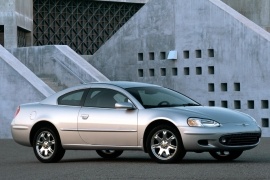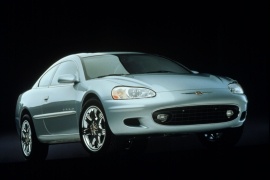CHRYSLER Sebring Coupe Models/Series Timeline, Specifications & Photos
First production year: 2000
Engines: Gasoline
Body style: Coupé (two-door)
In 2003, Chrysler introduced a facelifted version for the Sebring Coupe, trying to get more customers for this model, but it had to give up just two years later.
Based on the third generation of the Mitsubishi Eclipse, the Sebring Coupe was not exactly the kind of cars customers expected from Chrysler, and that was easy to see in the vehicle's sales. It was proof that an American design on a Japanese platform can't do wonders.
When Chrysler refreshed the Sebring Coupe, it brought a new front fascia. The new headlights sported a double-bubble on their lower side that emerged into the bumper. Moreover, the grille that filled the apron didn't look like a mouth anymore and sported four horizontal slats and, on the upper side, a chromed trim that supported the carmaker's badge. To underline these changes furthermore, Chrysler added a new set of fog lamps. From its sides, the Sebring coupe sported new side sill moldings, while at the back, the decklid was slightly modified to receive a new Chrysler badge in the middle. Also, the taillights featured a clear area for the reversing lamps.
Inside, the carmaker added a new, six-CD, in-dash stereo, replacing the previous one that could handle just four discs. Built quality, on the other hand, was not significantly improved, and there were still a lot of unusual noises coming from the redesigned dashboard that featured a new instrument cluster, with silver surroundings for the four-dial panel.
Chrysler offered the Sebring coupe with just two engines, one less than its predecessor. The base model was put in motion by a 2.4-liter inline-four, while the top-spec version came with a 3.0-liter V6. Both engines were produced by Mitsubishi. The only available transmission was a four-speed automatic.
The Sebring Coupe came in an era when Chrysler and Mitsubishi shared platforms and engines, and surprisingly, this model was more related to the Eclipse than to the four-door Sebring in terms of engineering.
While the sedan and convertible versions of the Sebring were based on the Chrysler JR platform, the coupe version shared its underpinnings with the Mitsubishi Eclipse. It was an unusual decision that paid back for the American automaker who learned from the Japanese automaker’s mistakes when it created this version of the Sebring.
The 2001 Sebring Coupe came as an affordable real four-seater coupe that young families or teenagers could use daily. Probably, it didn’t have the same dramatic sporty look as the Eclipse, but it was similar in performance and better in interior assessment. Furthermore, the longer wheelbase favored comfort.
In the 2000s, Chrysler’s design department was led by Thomas C. Gale, who was also responsible for the Sebring Coupe project. He and his team created a front fascia similar to the one installed on the sedan version, with organic-shaped headlights that combined the high and low beams and the turn signals under the same piece of rounded-shaped glass.
There was no upper grille above the bumper, only a lower one placed in the apron that also contained the optional fog lights and a pair of decorative side scoops. From its profile, the greenhouse was penned in a cab-forward styling, sporting rounded lines and generous window areas. Furthermore, there were no window frames for the doors, making the car look even sportier.
Finally, at the back, the short deck had a design that resembled the Chrysler 300M sedan, with its corner-mounted taillights and the recessed trunk lid on the rear fascia. The bumper was neatly integrated into the car’s shape and sported the fog and the reversing lamps.
Inside, at the front, Chrysler installed comfortable bucket seats, which, depending on the trim level, were covered in fabric or leather, while in the back, the automaker added a 60/40 split-folding bench seat. Fronting the driver was an instrument cluster that revealed recessed dials for the fuel level and the coolant temperature and large ones in the middle for the speedometer and the rev counter.
On the center stack, Chrysler added its CD stereo with an option for an in-dash 4 CD magazine and a three-way equalizer that enchanted its customers with a seven-speaker sound system. Underneath it, but still higher than in an Eclipse, the Sebring Coupe sported the HVAC controls.
Under the hood, Chrysler installed the same powerplants that moved the Eclipse. Customers could get the car with either a 2.4-liter or a 3.0-liter 24-valve, both featuring single-overhead camshafts (SOHC) paired with a standard five-speed manual or an optional four-speed automatic. The latter was also available with a manual function. Power went to the front wheels. For stopping, the Sebring Coupe had the same four-disc anti-lock braking system, which was not available on any cars back in 2001.

